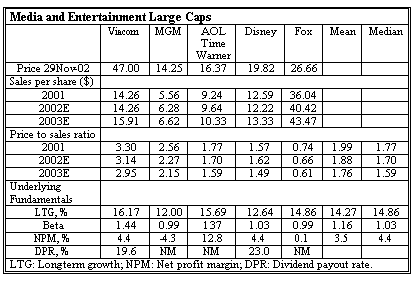Seeing is believing!
Before you order, simply sign up for a free user account and in seconds you'll be experiencing the best in CFA exam preparation.
Subject 6. Price to Sales PDF Download
A P/S multiple is a price multiple that divides the price per share by last 12 months' net sales per share.P0 / S0 = [(E0 / S0) (1 - b) (1 + g)] / (r - g) = [Net Profit Margin (1 - b) (1 + g)] / (r - g) 
Advantages:
- Sales are positive even when EPS is negative. P/S ratio is always meaningful.
- Sales are hard to manipulate.
- Revenues are generally more stable than net income for two reasons:
- Operating leverage - a part of total costs are normally fixed, and
- Financial leverage - some part of capital structure is usually represented by debt.
As a result, the P/S multiple is less volatile than the P/E ratio. - Studies show that P/S explains the differences in long-run average returns.
- The ratio is often employed for valuation of cyclical, unprofitable and mature companies.
Disadvantages:
- Sales do not imply profits. A company should generate earnings and be cash-flow positive in the long run to stay in business. Therefore, the P/S ratio alone cannot be regarded as a sole determinant of relative value. Not every stock with a low P/S multiple will be considered an attractive investment.
- Share price reflects the effect of financing but sales is a pre-financing measure. Comparing share price with sales per share is logically a mismatch.
- The ratio does not capture different cost structures. Only companies with similar cost structures and business models should be considered for the comparative analysis using the P/S multiple.
- Revenue recognition methods can distort reported sales.
Although determining sales is pretty straightforward, analysts should evaluate a company's revenue recognition practices before relying on the P/S multiple.
Valuation Based on Forecasted Fundamentals
Justified P/S:
It's obvious from the equation that the fundamental drivers of P/S are profit margin, growth rate and the required rate of return. The justified P/S based on fundamentals bears a positive relationship to the first two factors and an inverse relationship to the third factor. Note that the net profit margin is also a part of ROE (DuPont method), which is a component of growth.
Valuation Using Comparable P/S
- Same method as P/E and P/B.
- Low P/S => undervalued.
- Use trailing sales to calculate.
- In choosing comparables, control for
- Profit margin.
- Expected growth.
- Risk.
- Quality of accounting data.
Note that analysts usually compare only trailing multiples in case of P/B and P/S, since the consensus values of forecasted book values and revenues are not widely disseminated.
Example
Diane Stone is an investment banking analyst specializing in the media and entertainment sector. She is working on a secondary offering of MGM's shares and needs to determine if the company's stock is fairly valued at the current price level.
Since many companies in the media and entertainment industry demonstrate volatile, low or negative profit margins, Diane decides to use price to sales ratio to perform relative valuation against MGM's closest competitors.
She gathers the following data for her analysis:

As we can see from the table above, both trailing and leading P/S multiples indicate that MGM is overvalued relative to the industry. AOL Time Warner, Disney and Fox have lower multiples (all below 2.0), which makes them relatively undervalued compared to MGM, all else equal.
Diane decides to explore the reasons for the relatively high market pricing of MGM by looking at the company's underlying fundamentals. She notices, that although MGM's growth is lagging behind the industry, the company has a relatively low value of systematic risk (beta), especially comparing to its closest peers (in terms of P/S ratio) - Viacom and AOL TimeWarner. The low risk is associated with low required rate of return, which may partly explain the relatively high P/S ratio. MGM's profitability is a matter of concern, which confirms our hypothesis that the company is overvalued.
Diane concludes that today may be the perfect timing for a secondary offering of MGM shares if the company manages to secure sufficient demand for the issue.
User Contributed Comments 0
You need to log in first to add your comment.

I am happy to say that I passed! Your study notes certainly helped prepare me for what was the most difficult exam I had ever taken.

Andrea Schildbach
My Own Flashcard
No flashcard found. Add a private flashcard for the subject.
Add